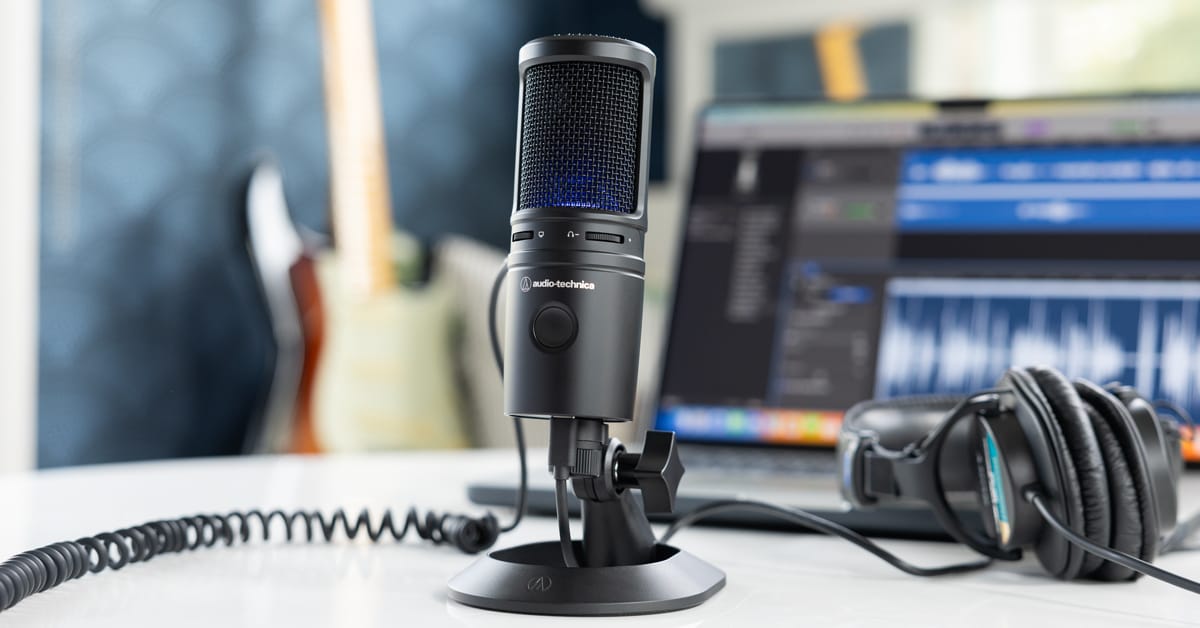If you need a microphone and want to make it easy, USB mics are hard to beat. Models like the Shure MV7 are popular with podcasters as a way to get professional audio without extra gear. Video game streamers and YouTubers often build their rigs around discreet options like the Shure MV88+ Video Kit. Musicians use digital mics to record vocals and instruments with ease, and get better sound for online music lessons.
They're also the best microphones for video calls. If you work from home or take remote classes, a USB mic is the easiest way to improve the clarity of your speech while reducing outside noise. Just plug your mic into the computer. Apps like Zoom and Microsoft Teams will let you select it as your audio source. No expertise required. Plus, many USB mics have a physical mute button, so you can be 100% sure nobody hears anything they shouldn't. We can't stress this enough: the mute button is the work-from-home feature you didn't know you needed.
At the heart of every USB mic is the ability to convert analog sound into digital data that your computer can understand. It’s really two items in one—an analog microphone and an audio interface. In practice, that means these mics are so convenient that you don’t even have to know what’s going on inside. However, they do vary in important ways. The quality of the converters, the type and number of capsules, stereo capability, accessories, included software and cost—these differences are what determine the best mic for your needs. So, make sure you know all the ways you want to use your mic. Are you recording to your computer or a tablet or phone? Are you planning to travel often with your mic? Are you recording two or more voices at once?
Make a quick list of everything you need your mic to do and consider what you’re willing to spend. This guide will make it easy to match your list to the perfect mic.
Note: If you see yourself expanding your recording to include multiple mics, instruments or other audio sources, consider getting an external audio interface. It’s the same conversion tech that’s built into a USB mic, but it can convert multiple sources at once, through one port on your computer. That leaves room to expand your setup. USB mics are best for people who want an easy, all-in-one solution centered on one mic. On that front, the convenience is hard to beat.
Table of Contents
The Top USB Microphones
Best USB Microphone for Podcasting: Shure MV7
Best USB Microphone Trusted by Musicians: Audio-Technica AT2020USB-X
Best USB Microphone for Working from Home: Shure MOTIV MV5
Another USB Microphone Option for Musicians: RØDE NT-USB+
A More Discreet USB Microphone: RØDE NT-USB Mini
Best USB Microphone for Next-Level Controls: Shure MOTIV MV51
Best USB Microphone Video for iOS and Android: Shure MV88+ Video Kit
Best USB Microphone for the Audiophile on the Go: Apogee HypeMiC
What's Next?
The Top USB Microphones
Best USB Microphone for Podcasting: Shure MV7
Quiet is hard to come by. Maybe you have a noisy roommate or rickety air conditioner. Maybe those car horns and sirens always pass at the exact moment you push the red button. For clear recordings without a vocal booth, we recommend the Shure MV7. It’s the best USB mic for eliminating unwanted sounds.
The MV7 draws inspiration from the Shure SM7B, one of the most celebrated vocal mics ever made. Both the SM7B and the MV7 have unidirectional polar patterns. This means they don’t pick up off-axis sounds. Shure designed the MV7 to record an area wide enough to allow head movement, but narrow enough to stay focused on your voice, not your dog walking around in the other room.
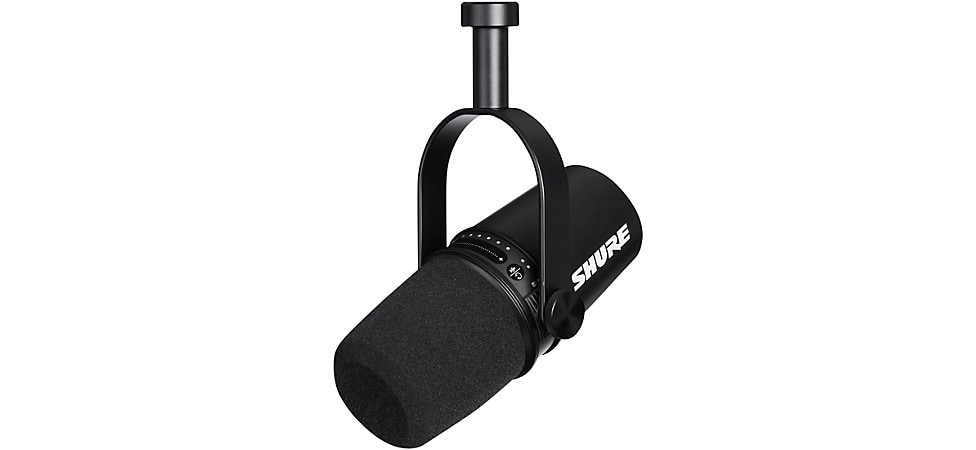
Shop Now: Shure MV7 Microphone
But software is where the MV7 pushes past the SM7B. Connect it to your computer with a USB cable, and you can control it with the Shure MOTIV app. For the “set it and forget it” podcaster, the Auto Level mode is best. Tell the app how far you are from the mic, pick a vocal tone and you’re off. It adjusts automatically to keep things even.
If you prefer to tinker, don’t worry—Auto Level is optional. The Shure MOTIV app has individual controls for gain, mix, EQ, limiter, all that jazz. There’s also a touch panel on the mic itself for adjustments on the fly.
Musicians can make good use of the MV7, too. Singers benefit from the same features as podcasters to get clear, isolated vocal tracks. It’s easy to fit the MV7 into larger rigs for instruments and full bands, thanks to the XLR connector. XLR lets you use the MV7 as an analog microphone, running through an interface. Podcasters will need this capability, too, if they ever want to record multiple mics at once.
Shure is trusted for a reason. For podcasters and vocalists recording outside a professional studio, the MV7 is a no-brainer.
Stepping up, check out the MV7+. Built specifically with podcasters and streamers in mind, Shure's MV7+ expands upon the MV7 to include LED audio metering and advanced onboard DSP processing. The MV7+ offers both XLR and USB-C connectivity, allowing for maximal versatility and use across various applications.

Shop Now: Shure MVyi Smart Mic and Audio Interface
But what if you need more than a single input? Maybe you've got an in-studio guest, or you're creating a tutorial and want to be able to add your instrument while you're livestreaming. Shure's MV7i combines the MV7's great sound with a built-in, two-channel audio interface. It's even capable of supplying phantom power to the XLR/1/4" combination jack on the back of the mic. Just plug in, set up a mix in your podcasting software or in the Shure MOTIV app, and you're good to go with a minimum of fuss and far fewer cables to get in your way.
Best USB Microphone Trusted by Musicians: Audio-Technica AT2020USB-X
The Audio-Technica AT2020USB-X is one of the most popular USB mics around, and for good reason. It's got neutral, accurate sound, plus a few features that make it especially useful for musicians. If you want to capture solo vocals, record instruments or take online music lessons over video chat, this mic deserves a serious look.
For musical applications, the AT2020USB-X benefits from pedigree. Audio-Technica is beloved among musicians for making high-quality, no-frills studio gear. You can trust their stuff to do what it says on the label, do it well and skip the gimmicks. The AT2020USB-X is based on Audio-Technica’s popular cardioid condenser mic, the AT2020, known for clean and crisp vocals. It produces that neutral “airy” effect sought by professional vocalists and sound designers.
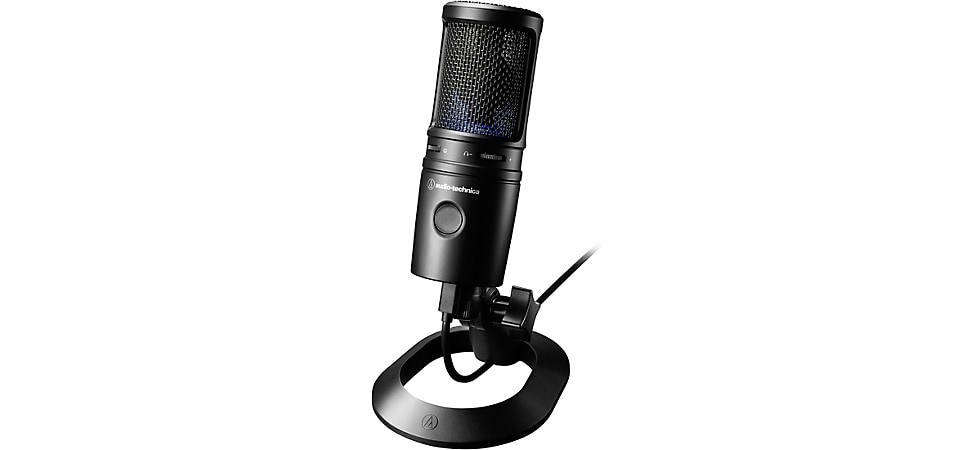
Shop Now: Audio-Technica AT2020USB-X
This USB model takes the AT2020 and adds the converter (of course), but also throws in some hardware features. It has a built-in headphone jack with a dedicated volume control so you can monitor while you record with zero latency. And in a gesture toward musicians, it also has a mix control, which lets you blend the sound from your mic with your computer audio. This is a game changer when you want to make quick adjustments to your headphone mix while tracking music, or balancing the sound of your own voice with other people on a call.
Keep in mind that the AT2020USB-X is a uni-directional mic. It excels at picking up audio from the front only. For musicians, that means you'll get the sound that makes the analog AT2020 so popular, while blocking unwanted noise. This mic is fantastic for recording and taking online music lessons. It can also be your go-to mic for calls or remote learning. If you're recording a single source at a time, it's hard to go wrong with this one. Plus, it's from a brand respected by audio pros worldwide.
Best USB Microphone for Working From Home: Shure MOTIV MV5
No list of microphones is complete without Shure, the ubiquitous maker of recording gear, including the SM57 and SM58, perhaps the two best-known mics on the planet. For digital mics, we’ll be looking at their MOTIV series.
The is a condenser mic that's perfect for Zoom calls and Microsoft Teams chats. That's partly due to the compact size. USB mics might not look big in photos, but you’d be surprised how much desk space the average one can take up. The MOTIV MV5 is only about 5.5" tall, so it's quite discreet for an important work meeting. There are other small options like the RØDE NT-USB Mini (see below), but the MV5 has an extra feature: a mute button. This button can save your life during calls for work or school. If you've never accidentally turned on your camera when trying to unmute yourself with the cursor, you're one of the lucky few. It's awkward. It's embarrassing. Don't let it happen to you. A built-in mute button prevents slip-ups like those, and it offers reassurance that you won't accidentally say the wrong thing on a hot mic.
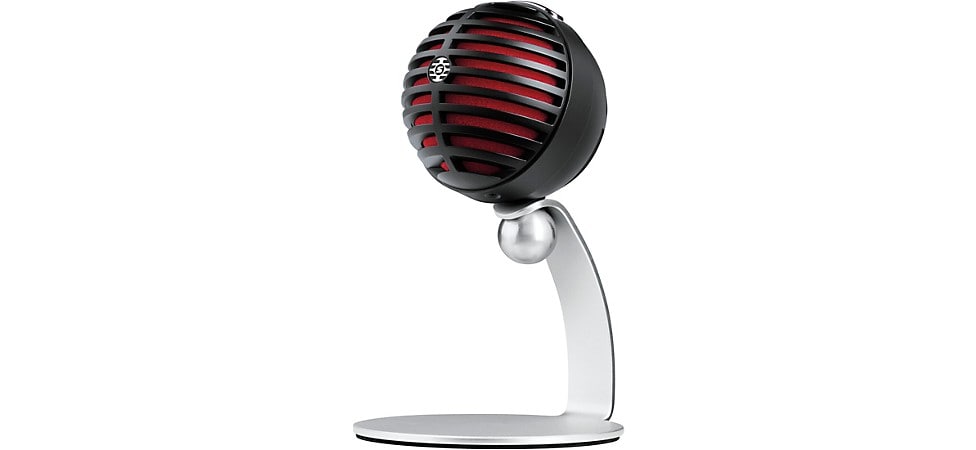
Shop Now: Shure MOTIV MV5
Beyond the mute button, the MOTIV MV5 also has useful controls for musicians. Three DSP modes are built into the mic: instrument, vocal and neutral. These settings give you a quick way to set it up for whatever source you’re recording, before doing any finer work in your DAW. It’s also a handy feature for anyone who livestreams music. You can flip from playing acoustic guitar to speaking with the push of a button.
Shure MOTIV mics also carry a unique feature for iPhone and iPad users, thanks to their premium apps. When attached to a MOTIV mic, the Shure MOTIV iOS apps let you manually control the gain on your mic, tweak other settings and monitor the waveforms. And if you record mobile video, the Shure Video App is best in class for recording video and audio at the same time on a mobile device.
If you’re looking for a desktop USB mic that stays out of your way, the MV5 is a solid option with a few convenient tricks up its sleeve. And it’s coming from Shure, a company known for making mics that hold up for decades.
Another USB Microphone Option for Musicians: RØDE NT-USB+
The RØDE NT-USB+ condenser mic has a lot in common with the AT2020USB-X, with a few extra features that justify the slightly higher price. It’s another side-address cardioid condenser (read: one source at a time), and it also comes from a respected name in music. It’s a USB option within RØDE’s well-regarded lineup of NT studio microphones. The recordings it captures are clear and neutral. Just like many other mics on this list, the NT-USB+ has a headphone jack with volume and mix controls. All this makes it great for the same applications: solo recordings and video calls.
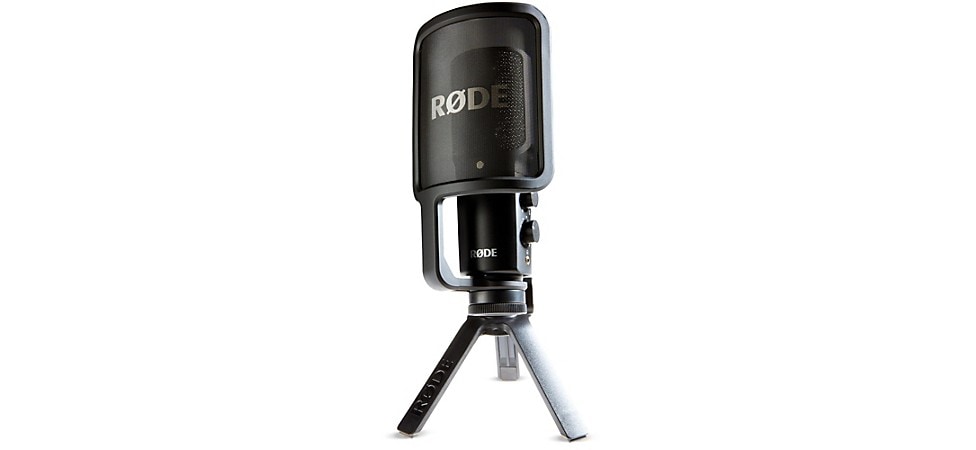
Shop Now: RØDE NT-USB+
In addition to the above, the NT-USB+ has a couple bells and whistles, the most important of which is a premium RØDE pop filter that mounts to the mic. If you’re singing or recording speech, you’ll eventually want to pick up one of these filters to prevent popping sounds from plosive sounds. A good pop filter doesn’t run cheap, so it’s a big plus to have one in the package, built to fit this specific mic. If you see similar mics that are less expensive, check if they have a pop filter. If not, the RØDE NT-USB+ could end up being a premium option that also saves you cash in the end.
RØDE is also handy for travel, since the mic is smaller than many other options, and it can be easily detached from the stand and pop filter. And thanks to a sloew of free RØDE apps for iOS and desktop, recording on the go is easy, with no questions about compatibility with third-party apps (though it works with lots of those, too).
A More Discreet USB Microphone: RØDE NT-USB Mini
The RØDE NT-USB Mini takes a lot of what we love about the NT-USB and shrinks it down, both in size and price. It’s still a cardioid condenser that provides high audio quality, especially for voice, and it has the built-in headphone jack and volume control (no blend, though). That makes it work for the same users: solo podcasters, streamers and vloggers, plus musicians who just need one mic. But what really shines about the NT-USB Mini is just how unobtrusive it is, even while offering studio-quality sound.

Shop Now: RØDE NT-USB Mini
The attached mount keeps the NT-USB Mini shorter than 6" while still allowing for 360º rotation and vertical swiveling. It’s always free to face the right way without rearranging your desk. For Zoom calls and streaming, the small size keeps it out of the frame. If you work in an office and don’t want questions about the big microphone on your desk, the NT-USB Mini can slide right in between your monitor and coffee cup. And the styling is subtle, with all-black coloring and a squared-off vintage shape that’s quite attractive. Find the right spot and you’ll forget this mic is even there—in a good way.
Best USB Microphone for Next-Level Controls: Shure MOTIV MV51
The Shure MOTIV MV51 has the same vintage vibes and modern approach you see with the MV5, but pretty much everything about it is heightened. It’s a large-diaphragm condenser, with the recognizable square throwback shape to match. The larger diaphragm gives it a lush sound, especially for vocals, and picks up slightly wider angles. For game streams and video calls, that means you can move around more without messing up the audio quality. And in keeping with the premium price tag, the MV51 has solid all-metal construction that’s durable and feels nice in your hand. That being said, the best reason to get the MV51 is the enhanced controls.
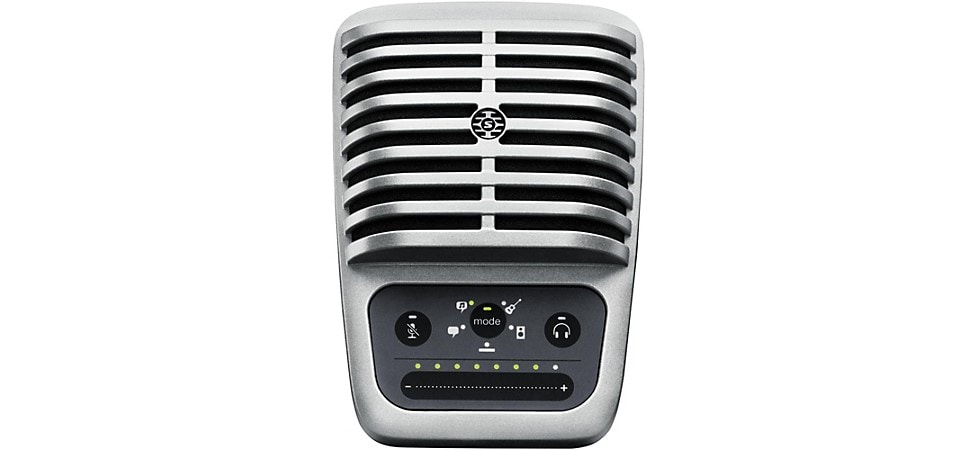
Shop Now: Shure Motiv MV51
Rather than three DSP preset modes, the MV51 has five—speech, singing, flat, acoustic and loud—and they’re all controlled with a touch interface. In addition to buttons that mute the mic and headphones, there’s also on-unit gain control. This is a rare feature in USB mics, which typically rely on software alone to control the gain.
The MOTIV MV51 also comes with all the benefits of the MV5, including Shure’s apps and expert build quality. It’s good for all kinds of desktop uses, especially those that lend themselves to large-diaphragm condensers.
Best USB Microphone for Video for iOS and Android: Shure MV88+ Video Kit
For a lot of mobile videographers, the smartphone cameras of today are more than good enough for a professional result. The microphones, not so much. The Shure MV88+ Video Kit solves that problem. It takes all the thoughtful features of the MV88 and applies them to mobile video recording on iOS and Android 6.0 or later. If you want to record good audio for your smartphone videos and don’t mind paying a premium, the MV88+ is the best-in-class solution to get it right.
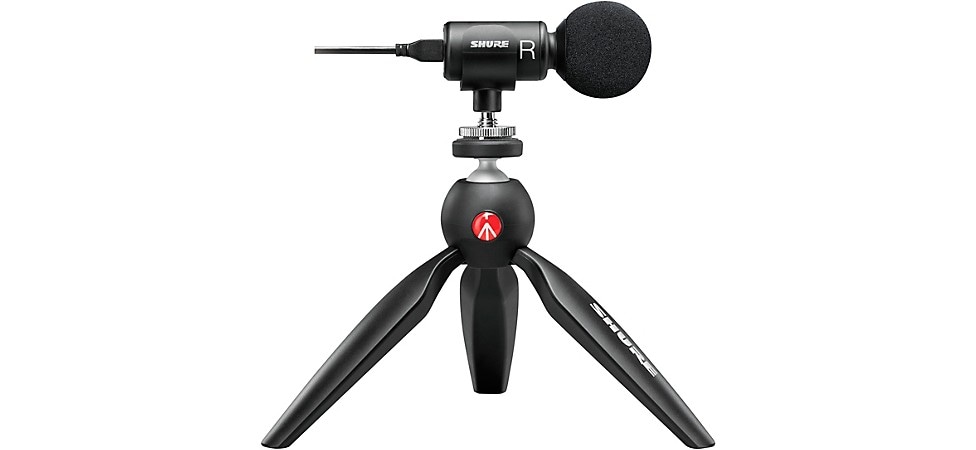
Shop Now: Shure MV88+ Video Kit
The Shure MV88+ video kit comes with an adapted version of the MV88 mic, which attaches to a phone clip to orient the stereo capsules toward whatever you’re filming. The clip also attaches to the included tripod stand, which can fold down to a handle for filming on the move. The mic itself has a connector that works with included Lightning and USB-C cables to connect to iOS, Android and even Windows or Mac computers. The computer compatibility makes it a great way to record videos at home, too, since smartphone cameras have far outpaced the webcams on laptops. When using the Shure MOTIV Video app for iOS, you can monitor audio and video at the same time without switching apps, turning your phone into a powerful production studio. If you’re using Android, the kit is compatible with apps that allow external mics.
If the Shure MV88+ video kit is within your budget and you want the best mobile audio/video recording combination you can get on your smartphone, it’s hard to recommend anything else. It fits a video production studio into a carrying case.
Best USB Microphone for the Audiophile on the Go: Apogee HypeMiC
Many USB mics come from brands that made analog mics first, but the Apogee HypeMiC comes at it from the other direction. Apogee specializes in digital audio conversion. They make some of the best audio interfaces you can buy, from desktop models all the way up to super-expensive studio racks. One of their most acclaimed products is the Apogee Duet 3, an interface that fits top-tier conversion into a highly portable size. That’s the same philosophy that the HypeMiC follows, and the results are uniquely impressive for podcasters and musicians alike.
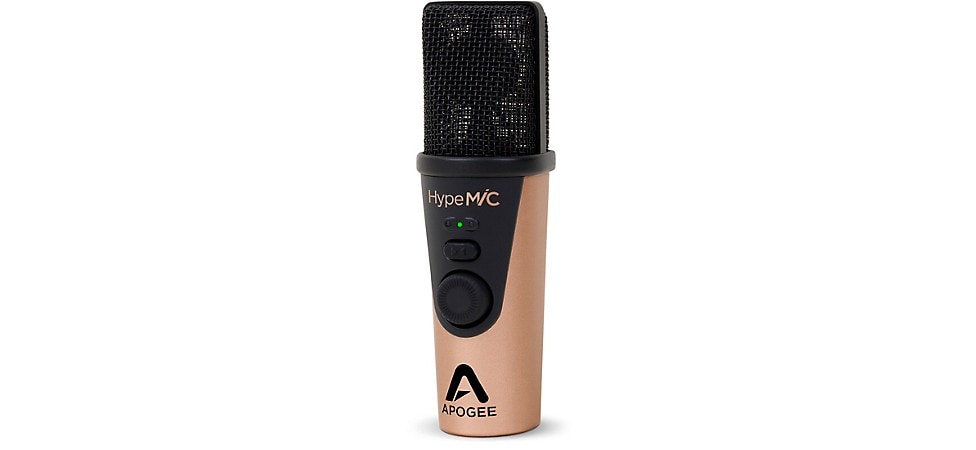
Shop Now: Apogee HypeMiC
The HypeMiC delivers some of the best audio on this list, and it does it in a package that’s even smaller than the two “small” desktop mics we already listed, the RØDE NT-USB Mini and the Shure MOTIV MV5. This thing weighs less than half a pound, and it can get excellent recordings of everything from quiet vocals to wailing guitars.
How do they do it? Analog compression. In addition to a quality converter and cardioid capsule, this mic contains an analog signal path that can compress audio before it’s converted. If you’re an audiophile, you know that would be impressive in any USB mic, let alone one this tiny. The compression gives incredible presence to voice and instrument recordings alike. It’s part of why this mic can handle such a range of sources and make them all sound great. External controls let you switch between different levels of compression—shape, squeeze and smash. For podcasters and streamers, the compression will give your voice a broadcast “pop” that’s tough to emulate. And the fact that it does this to the analog signal, rather than using DSP presets, puts the HypeMiC in a class of its own.
In keeping with its size, the Apogee HypeMiC comes with a small carrying case that fits the mic and all the accessories. That includes a tripod, nice pop filter and cables for Lightning, USB-A and USB-C connection to phones and computers. It also has a headphone jack with a blend function, plus another rarity: stereo monitoring. You can output to speakers or run the audio into an interface to integrate into a larger setup. The three lights on the front help you monitor the audio to avoid clipping.
With its built-in compression, the Apogee HypeMiC harnesses one of the best features of analog recording and puts it into a near-handheld size. In this sense, it stands alone among USB mics for the kind of presence it can add to your recordings. You pay for it—the HypeMiC is the most expensive mic on this list. But considering that other USB mics give you no access to the analog stage at all, the price can be well worth it.
What’s Next?
The main benefit of a USB mic is that it’s a simple solution. You just plug it in and you’re good to go. From there, it all depends on how you like to edit your recording, and that depends on what DAW you use. For a rundown on the best DAWs, check out the DAW section of our home recording article. And as always, you can get in touch with our experts online, by phone or in-store for help with whatever you need.







